Leonard Brillson
Editor, INTERSECTIONS
Member, Government Affairs Committee
Welcome to our INTERSECTIONS Newsletter!
Since our last newsletter, major appropriations bills have moved forward on Capitol Hill that directly affect federal support for our science and technology community.
The MRS Government Affairs Committee (GAC) aims to understand the dynamically changing legislative policy environment and its impact on materials research. GAC Chair David Norton highlights the major impact that materials research continues to have in improving our quality of life and advancing our international competitiveness.
Our MRS Washington consultant Damon Dozier describes the spending bills now making their way through Congress.
Our Grassroots Subcommittee Chair Boris Dyatkin describes how we are aiming to maximize the impact of our Materials Voice campaign to raise awareness of Congress to key materials research initiatives.
In the Fellowship Corner, Congressional Fellowship Program Chair Ashley White announces the arrival of MRS’s newest Congressional Science and Engineering Fellows, the activities of this past year’s Fellows, and the opportunity to apply for 2019–2020 MRS Congressional Fellowships.
Bill Hammetter our Congressional Visits Day Chair describes the upcoming Fall CVD visits to both Capitol Hill and multiple science funding agencies.
Government Agencies Subcommittee Chair Diogenes Placencia describes the success of this year’s joint meeting with the Mexican Society of Materials and plans to expand international collaborations between U.S. and Mexican scientific agencies.
Finally, Jessica Winter’s INTERSECTIONS article on value-added materials science in this issue features yet another success story, highlighting how federal investments in materials science pay off in ways that the general public and especially our elected officials can relate to.
MRS is working hard to make sure that the materials research community is being heard and that it has input in developing effective government policy for support of materials science. Here is the latest news.
Government Affairs Committee Chair News—The Importance of Science Advocacy
 David Norton
David Norton
Chair, Government Affairs Committee
One of the primary missions of government is to prepare our society for the future that lies ahead, identifying those challenges and opportunities that require the collective attention, foresight, and public investment that only government can provide. Support for scientific research has been, and remains, one of our nation’s cornerstones that the federal government largely stewards for the benefit of current and future generations. Leadership in both fundamental and applied research is key to our nation’s competitiveness in emerging technologies. And the fingerprints of materials research can be found in most, if not all, of these advances.
We are living in an age where technology is fundamentally changing how we live our daily lives at a pace that is remarkable. Audio speakers are becoming internet-connected personal assistants, wristwatches that used to simply tell time now track our heart rate, overall fitness and email. Automobiles now “see” behind and around us, suggest to us faster routes based on current traffic, and will soon require no human driver, a role that historically served as a rite of passage to independence for teenagers. If you unpack each of these enabling technologies and look closely within its DNA, you will find specific materials developments without which that technology would not be realized. Whether within the sensor, communication circuits, computational electronics, or physical structures, these technologies would not be possible except for fundamental materials research done earlier, sometimes decades prior, and often with support from federal agencies.
The focus of materials research is on both the immediate and the long haul. There are instances where technology identifies the questions for materials research, semiconductors that need to be faster, photovoltaics in need of higher efficiencies, structural materials that need to be stronger and lighter, and plastics that need to be more biodegradable. Yet each of these efforts builds on previous research often carried out with little immediate insight into specific applications or technologies that will benefit. In materials research, we are constantly creating design tools whose use is not yet fully envisioned, investigating phenomena not yet exploited, and discovering new materials and properties whose ramifications or use will be unraveled by future generations. Such forward-looking activities are not within the domain of private sector business. It flourishes and establishes leadership only in those countries that remain committed to supporting scientific discovery and knowledge creation.
Within the MRS community’s efforts to advance the boundaries of knowledge and insight in materials science, our most important partners remain those government entities whose missions include the advancement of science and knowledge for future generations. Despite the ever-changing political landscape in Washington DC and elsewhere, the support for fundamental research, more specifically for materials research, has remained consistent and true with our elected officials from all political persuasions. As we move into and through the upcoming election cycle here in the US, it is important that we continue to highlight and communicate the beneficial impacts of yesterday’s research on the realities of today. The future of our nation’s health and prosperity depends on this continued commitment to supporting research. Materials research yields new concepts, improved performance, and advanced technologies for a better tomorrow.
What's Happening in Washington
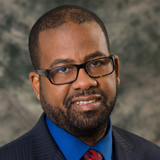 Damon Dozier
Damon Dozier
MRS Director of Government Affairs
Since Congress has been in recess, the summer has been a quiet period in terms of resources and resource development for materials research and the materials research enterprise. While the House of Representatives has been particularly active in passing funding bills, the Senate has been preoccupied with a number of issues, including a Supreme Court nomination, the appointment of a new Office of Science and Technology Policy (OSTP) director in the White House, and the possibility of advancing the President’s agenda of curtailing government spending.
On the Senate side, a bill cleared to approve a second appropriations measure funding four federal departments as Congress works to meet a September 30 deadline for keeping the government open. In a 92-6 vote, the Senate approved a “minibus” funding the Agriculture, Transportation, Housing and Urban Development (HUD) and Interior Departments. The $154.2 billion measure also provides funding for financial services and general government. The Senate has now approved packages that include funding for agencies and programs in 7 of the 12 traditional bills that need approved to fund the government. The legislation largely rejects President Trump’s budget proposal, which sought massive cuts in discretionary spending. The Senate bills are part of a framework that would increase discretionary spending by $5 billion compared to 2018. The Senate also rejected the more partisan approach in the House, where companion bills include conservative policy riders deemed “poison pills” by Democrats. The policy riders in the House bills seek to cancel Obama-era environmental regulations and shield politically active churches from losing their tax-exempt status. The different approaches will lead to a battle between the House and Senate in September when the lower chamber returns from session. Senate Majority Leader Mitch McConnell (R-KY) is seeking to avoid both a shutdown and the need to pass a mammoth omnibus-spending bill. President Trump vowed to never again sign an omnibus of that size after doing so earlier this year. They are expected to get up to 9 of the 12 spending bills to President Trump’s desk before the September 30 deadline. Doing so would mean Congress would also have to approve a short-term continuing resolution (CR) to fund the rest of the government.
Grassroots Subcommittee Chair News
 Boris Dyatkin
Boris Dyatkin
Chair, Grassroots Subcommittee
The Grassroots Subcommittee is gearing up for a jam-packed legislative session that will soundly impact science policy, funding, and research priorities of thousands of MRS members. Comings off the heels of intense congressional visitations day outreach efforts by the GAC, as well as concerted lobbying efforts on the Hill, we are closely evaluating the emerging political landscape in an effort to maximize the impact of our upcoming Materials Voice campaign. Already, we are seeing signs of progress. Nominees are filling several once-vacant science policy positions in the government – an area of extreme concern for scientists nationwide and the subject of many recent Materials Voice letters. Our efforts – your voices – are making an impact, and we will ensure that our advocacy efforts continue to serve the scientific community, and specifically, the MRS community.
As we prepare our Materials Voice letters for the upcoming Fall MRS Meeting in November, we call upon all of our MRS Members to follow along with the recent developments coming out of Washington DC. The implications of the passage of the federal spending budget, effects of shutdowns or continuing resolutions, the National Quantum Initiative bills, and research priorities spelled out in the most recent National Defense Authorization Act are just a few of the myriad of issues that directly affect the state of scientific research in the United States. These decisions are made, in part, following advocacy and guidance from groups like MRS. We ask you, the members, to: 1) remain informed about the latest policy developments; 2) consider the short- and long-term effects of specific policies on your research, institution, and education priorities; 3) discuss these issues with your peers; and 4) use the upcoming Materials Voice initiative to reach out directly to the decision-makers. Your advocacy efforts are essential in our noble pursuit of sound science policy, and your voices, concerns, success stories, and opinions are vital for these efforts.
MRS Congressional Science & Engineering Fellowship Corner
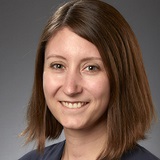 Ashley White
Ashley White
Chair, Congressional Fellowship Program
The MRS’s newest Congressional Science and Engineering Fellows have arrived in Washington, DC!
At the beginning of September, 2018–2019 Congressional Fellows Dylan Rittman [MRS/The Optical Society (OSA)] and Michele Bustamante [MRS/The Minerals, Metals and Materials Society (TMS)], joined nearly a dozen former MRS Fellows for the annual kickoff breakfast in Washington, DC. In addition, four former MRS Fellows based in the San Francisco Bay Area convened for a send-off event in late August for Dylan Rittman, who just finished his Ph.D. at Stanford.
These gatherings have become a tradition, allowing incoming fellows to receive valuable advice from former fellows, and strengthening connections among the growing body of more than 30 MRS fellowship alumni spanning the now 24 years of the Fellowship program. The alumni network boasts leaders in positions across the spectrum including academia, industry, startups, government and policy, as well as a number who have remained on the Hill in various capacities.
Dylan and Michele are now wrapping up a two-week-long science policy orientation program organized by the American Association for the Advancement of Science (AAAS) to provide an introduction to the policy and political landscape before they begin interviewing with Congressional offices to find their placement for the duration of their fellowship year. Look for an update in a future issue of INTERSECTIONS for information on their placement offices and policy issue areas.
Our 2017–2018 MRS Congressional Fellows, Sarah Vorpahl (MRS/OSA) and Scott Litzelman (MRS/TMS) have completed their fellowship year, working in the offices of Senator Bernie Sanders (I-VT) and Senator Ron Wyden (D-OR), respectively. During her fellowship year, Sarah covered energy and environmental issues for Senator Sanders. She’s thrilled to now be able to apply her expertise in federal policy to the state and local level through her new position as a Senior Energy Policy Specialist working in the Washington State Energy Office, where she will focus on distributed energy resources (DER) policy, including grid integration, small-scale solar installations, interconnection, and the deployment of DERs for community resilience benefits.
During his fellowship year, Scott covered a portfolio comprising energy storage, energy efficiency, grid modernization, and resiliency. He’s now moved to the U.S. Department of Energy (DOE) as a Program Director at the Advanced Research Projects Agency-Energy (ARPA-E), where he will leverage his policy experience to initiate and manage R&D programs in areas such as energy storage and carbon capture.
Applications for the 2019–2020 MRS Congressional Fellowship are due January 4, 2019. If you’re interested in learning more about the program and will be at the MRS Fall Meeting in Boston, I encourage you to come to our information session on Monday, November 26 from 5:15–6:15 pm.
Fall Congressional Visits Day
 William Hammetter
William Hammetter
Chair, Congressional Visits Day Subcommittee
The MRS sponsored Fall 2018 Congressional (Agency) Visits Day is scheduled for October 9 – 11, 2018. The specific purpose of the Fall assault on the Hill is for the MRS elected officers and Board Members to meet with targeted Senate and congressional committees (on October 10) and visit government agencies (on October 11) that historically, or potentially, fund research important to MRS Members. Our group of 5 – 6 MRS Officers will visit the House Science Committee (of both the majority party and the minority party), the House Energy and Water Appropriations Subcommittee, the Senate Commerce, Science & Transportation Committee, and specifically, the Subcommittee on Space, Science & Competitiveness. The targeted Agencies include the Department of Energy, the Department of Defense, NSF, ARPA-E and the program officer from the EFRCs. It will be full dance cards for our MRS Officers. As always, the message will be clear; Fundamental scientific research plays an important part in the lives of all, and sustained, even enhanced, government support of the effort should continue. Of course, there will be more to report after the meetings. Please remember that you can be a part of the efforts to support funding for fundamental research. All scientists need to develop an expertise in delivering a clear, concise, understandable message to lawmakers, and others, about the benefit derived from fundamental scientific discoveries.
2018 MRS Fall Meeting—
Conversations with Government Agency Representatives Regarding Funding in Research
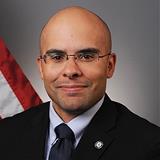
Diogenes (Dio) Placencia
Chair, Government Agency Subcommittee
Dear Members:
As always, our Subcommittee sends happy wishes for you and your families, especially during these summer months where we get to enjoy the fruits of our labor. Some of you may not know that the MRS holds a joint meeting with the Mexican Society of Materials (SMM) each year in Cancun, MX (the International Materials Research Congress – IMRC). This is the flagship meeting of SMM, with a large number of symposia, events, and of course, a nice beach right next to the venue. MRS has been holding this conference jointly with SMM for 10+ years now, with a high level of success to show for it: more involvement from MRS Members, a highly engaging environment from which many collaborations have developed and cross-cultural events that brings us closer together as a materials community.
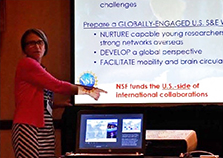 At the 2018 IMRC, our Subcommittee on Government Agencies launched an effort to bring awareness of funding opportunities to materials researchers in Latin America. Modeled much like our Research Funding Opportunities at the MRS Spring and Fall Meetings, we invited several Program Officers to present themselves to the community, describe their funding priorities, and to have an open Q & A session. This year, representatives from the U.S. National Science Foundation (NSF), the U.S. Army’s RDECOM Americas, the U.S. Air Force’s SOARD office, and the Office of Naval Research Global (ONRG) participated in an event that was very well attended. (See Linda Sapochak describing NSF – supported collaborations to the right.) A high degree of interaction was noted throughout the session, with overall positive response from the audience. See audience photo below left. Considering the success of the session, it is highly anticipated that this event will be held once more in the following IMRC, with the hopes of involving other institutions like the European Union and Mexico’s CONACYT (Mexico’s equivalent of the U.S. NSF).
At the 2018 IMRC, our Subcommittee on Government Agencies launched an effort to bring awareness of funding opportunities to materials researchers in Latin America. Modeled much like our Research Funding Opportunities at the MRS Spring and Fall Meetings, we invited several Program Officers to present themselves to the community, describe their funding priorities, and to have an open Q & A session. This year, representatives from the U.S. National Science Foundation (NSF), the U.S. Army’s RDECOM Americas, the U.S. Air Force’s SOARD office, and the Office of Naval Research Global (ONRG) participated in an event that was very well attended. (See Linda Sapochak describing NSF – supported collaborations to the right.) A high degree of interaction was noted throughout the session, with overall positive response from the audience. See audience photo below left. Considering the success of the session, it is highly anticipated that this event will be held once more in the following IMRC, with the hopes of involving other institutions like the European Union and Mexico’s CONACYT (Mexico’s equivalent of the U.S. NSF).
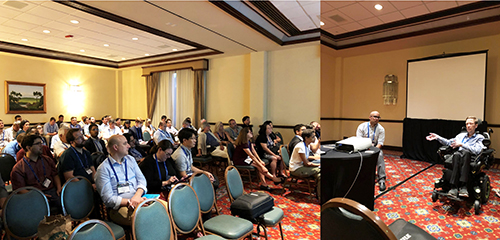 So as we anticipate yet another successful Fall Meeting (great lineup of Program Officers presenting this year), keep in mind that we as a Subcommittee take our responsibilities to improve your experience with great seriousness. As volunteer members ourselves, we understand how these events are critical to your careers, knowledge base, and most importantly, your livelihoods. Every decision we take is with you in mind. I’m always here to help in any way possible. Until next time.
So as we anticipate yet another successful Fall Meeting (great lineup of Program Officers presenting this year), keep in mind that we as a Subcommittee take our responsibilities to improve your experience with great seriousness. As volunteer members ourselves, we understand how these events are critical to your careers, knowledge base, and most importantly, your livelihoods. Every decision we take is with you in mind. I’m always here to help in any way possible. Until next time.
A Value-Added Materials Research Story—From Quantum Dots to Personalized Medicine
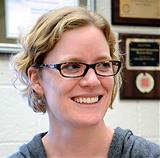
Dr. Jessica Winter
Professor, The Ohio State University
Chief Technology Officer, Quantum Core Technologies
In 2007, as a newly minted assistant professor, I was awarded my first grant from the National Science Foundation to create nanoparticles to study mechanical forces inside cells. This research is important because cells exert mechanical forces when they move and grow, thus this technology could provide additional information on pathologies like wound healing and cancer. The nanoparticles I envisioned would be small enough to enter a cell, provide a visual tracking signal (fluorescent), and be manipulated by external magnetic fields (magnetic). Unfortunately, after two follow-on grants, my research did not work as planned. Although my team was able to create nanoparticles that we could track and move, we could not introduce them into cells. At first glance, this might seem a failure. However, as research often does, my work took a different direction.
I realized that this technology could be used in a different application, personalized medicine, in which patients are matched to therapies based on specific proteins or genes (i.e., biomarkers) in their body (Figure 1). This increases the chance for successful treatment, and reduces time and cost of unsuccessful therapies. However, personalized medicine requires that many different biomarkers be evaluated at the same time, and current technologies (i.e., dye molecules) were limited to ~3-4 markers because of signal overlap. In contrast, nanoparticles could image 8-12 markers at the same time. An additional problem was that most cells in a patient biopsy are normal, making it challenging to find the diseased cells needed to make the diagnosis. However, because these nanoparticles are magnetic, diseased cells could be isolated using magnetic fields. Thus, I turned my attention to developing technologies for cancer diagnostics.
Initially, my team and I studied patient samples that we knew expressed the biomarkers of interest. Based on these preliminary successes, we were invited to participate in the National Science Foundation I-Corps program, an entrepreneurial boot camp to help scientists and engineers learn how to commercialize their work. We had planned to sell our product to researchers studying biomarkers, but through I-Corps, we learned that this market was too small to sustain a company. We were encouraged to explore other markets and learned about clinical flow cytometry used to diagnose leukemia and lymphoma. Although we had no experience with this market, it seemed a perfect fit for our technology because the nanoparticles are not required to enter the cell (the biomarkers reside on the cell surface) and the cells are in blood, making it easy to employ magnetic forces to isolate them (no need to homogenize tissue).
Figure 1: Breast cancer patient cells that have been labeled for the HER-2 biomarker (white) using nanoparticles. HER-2 is a biomarker used to indicate patient treatment with trastuzumab therapy.
After I-Corps, we filed a patent and started a company (Core Quantum Technologies). We also met the company’s current CEO through I-Corps.
The next step would have been to test our technology with animals; however, we realized that we could not make enough product to do so with our existing process. Thus, we applied to the National Science Foundation “Scalable Nanomanufacturing” program to develop new manufacturing technologies to create large amounts of these materials. We partnered with two other faculty members with experience in high throughput manufacturing and computational modeling of particle formation. We also partnered with two companies, including my own, both of which emerged from federally funded research. We increased our production volumes by ~ 50 fold, enabling commercialization and testing.
The company I formed has received funding from state, federal, and private sources, and has grown from 2 part-time to 3 full time employees (Figure 2). We are expecting to hire 2 more soon. These are high paying, high tech jobs that enrich the biotechnology infrastructure in Ohio, often considered a fly-over state. We are also proud that our technology company is founded and led by women. We have already begun product beta testing and plan sales by the end of the year.
None of this would have been possible without federally funded research, from the initial small exploratory grant that I received to the small business innovation research (SBIR) grants that the company has obtained. Most importantly, I never could have predicted the direction that my research and innovations would take. Examples like these abound. Green Fluorescent Protein, one of the most important tools in the biotechnology industry, was originally discovered in jellyfish research. Adaptive optics, a method used to improve medical imaging, was originally developed for astronomy telescopes. These results reinforce the importance of continued American investment in basic research to stimulate the economy. Even when the implications of that investment are not immediately obvious, research often takes an unexpected turn, creating jobs and stimulating growth.
Figure 2: Core Quantum Technologies Team. (Left to Right) Research Scientist Dr. Qirui Fan, CEO Kristie Melnik, technician Betty Pritchard.
Feedback
We welcome your feedback and invite you to submit topics for consideration in future issues of this newsletter. If you have or know of stories that illustrate how an investment in materials research paid off in real dollar terms, please send your suggestions to INTERSECTIONS Editor, Len Brillson, at [email protected]. Please send your comments to [email protected].
Sign up for MRS newsletters and alerts by visiting My MRS. There you can login or create an account, and select INTERSECTIONS under Public Policy to receive this quarterly newsletter via email.
Not a current MRS member? It’s never too late to join or renew.